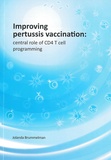Improving pertussis vaccination
Central role of CD4 T cell programming
Summary
The introduction of whole cell pertussis (wP) vaccines in the 1950s led to a massive decrease in pertussis incidence and mortality. However, since a few decades, resurgence of pertussis is observed in highly vaccinated populations. Several explanations have been proposed to underlie the resurgence of pertussis, including pathogen adaptation and waning vaccine-induced immunity, especially after vaccination with currently used acellular pertussis (aP) vaccines. Suboptimal long-term duration of protection by aP vaccines may be caused by the induction of (i) an immune response with a narrow-specificity since it only contains 1-5 antigens, (ii) a suboptimal functional programming of the CD4 T cell response, (iii) end-stage differentiation of the CD4 T cells most likely due to the high antigen concentrations, (iv) and absence of mucosal immune responses in the respiratory tract. In this thesis, several alternative approaches for current pertussis vaccination were applied in mice and compared using innovative and systems based technologies, with the main focus to understand the molecular basis for the different outcomes in the CD4+ T helper cell (Th) response. By applying these technologies, detailed molecular signatures of B. pertussis infection-induced immune responses, known to provide relatively durable protection, were obtained in mice. Infection eventually led to the induction of a Th1 and Th17 CD4+ T cell response. The CD4+ T cell response after vaccination with the current aP vaccines, however, led to the induction of a Th2-dominated response. This might be due to the fact that the aP vaccines do not contain Th1 and Th17 skewing pathogen-associated molecular patterns (PAMPs). Addition of a non-toxic lipopolysaccharide derivative, a PAMP that activates pattern-recognition receptor Toll-like receptor 4, to the aP vaccine induced based on cytokine secretion a shift from a Th2 towards a Th1 and Th17 response. Yet at the gene expression level, no difference in expression of Th2-associated genes, but only upregulation of Th1- and Th17-associated genes was observed. A new generation candidate vaccine, an outer-membrane vesicle (OMV) vaccine, tackled the suboptimal functional programming of the CD4+ T cells and in addition also some other shortcomings of the aP vaccines. This vaccine has a broad antigen composition and contains PAMPs. Pulmonary rather than subcutaneous administration of this vaccine led to an more effective protective immune response and was, based on molecular signatures and Th cell outcome, comparable to that after B. pertussis infection. In conclusion, for designing or implementing improved pertussis vaccines, it is important to include Th1 and Th17 skewing PAMPs or adjuvants and a broad antigen composition with an optimized dose. Moreover, carefully evaluation of the appropriate functional programming and memory potential of the specific CD4+ T cells induced for providing sustained protective immunity against infection is needed. This thesis improved our insight into the immunological signatures and features of CD4+ T cell programming that are key for protective immunity to B. pertussis and should be induced by new types of vaccines. Yet there is a long road ahead in the development and implementation of such vaccines.
